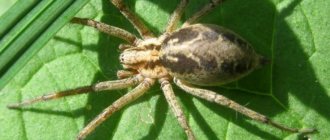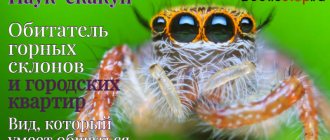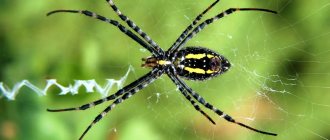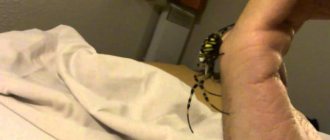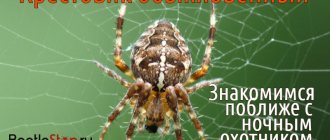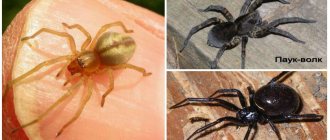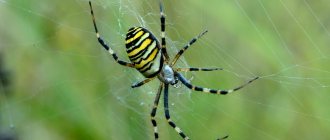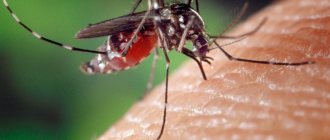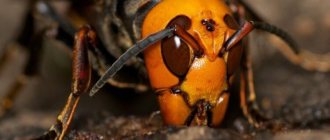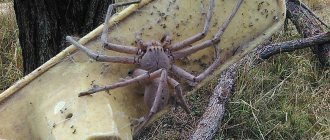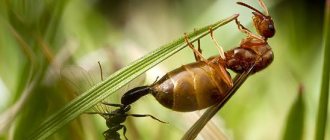Any spider has a pair of fairly powerful poisonous fangs that inject toxin into the body of the victim. This is not just poison, but a digestive juice that turns prey tissue into a liquid pulp, which the spider later sucks out of the chitinous shell. There are approximately 42 thousand species of these arthropods in the world, but only a tiny fraction of them are dangerous to humans. As a rule, spiders are simply too small and not aggressive, and are not capable of biting through human skin. Sometimes some species bite people, but their bites pass without any consequences. No more than a hundred people reliably died from spider bites in the last century, but nevertheless it is useful to know about the TOP most poisonous spiders.
Sydney leukoweb spider
Atrax robustus (Sydney leukoweb spider) is the most venomous spider in the world. It is included in the Guinness Book of Records. This is one of the few species of spiders that can kill a person with poison:
- The spider lives in Australia, mainly in the state of New South Wales. Often found around Sydney.
- Has a black or brown color.
- Its length can reach 5 cm, and the largest individuals are 10 cm.
The spider's diet consists of large insects and other arachnids. Atrax robustus is dangerous for humans because it has a very strong poison and this species weaves webs in residential buildings, which increases the chance of residents encountering a spider. The arthropod immediately attacks if it believes that there is a threat to it.
Sydney leucopaweb spider: Wikipedia
Determine the location of the bite by fang marks and a strong burning sensation. The spider bites tightly into the victim and can bite several times, introducing more and more poison. After a bite, symptoms appear almost immediately, which progress and can be fatal:
- salivation:
- muscle spasms;
- difficulty breathing;
- confusion and disorientation.
Without immediate medical attention, a person may lose consciousness and die. Since the invention of the antidote in 1981, no deaths from Atrax robustus venom have been recorded.
Secretive six-eyed
The central regions of South America and the deserts of Africa are home to a small (body up to 1.5 cm, legs about 5 cm) killer six-eyed sand spider. Outwardly, it resembles a crab, the color is yellow or brown in different shades, allowing it to blend in with the surrounding soil. That is why it is also called sand spider or crab spider. Its characteristic feature is the presence of three pairs of eyes instead of the traditional four. It can live up to 15 years; in other species this value does not exceed 3.
Six-eyed spiders almost never weave webs. Exceptions are the cocoon sacs in which the female lays her eggs. These spiders hunt by waiting for prey in ambush. They are generally secretive and prefer to avoid people. Therefore, although they are very poisonous, only 2 of their victims have been recorded. The deadly substance injected by the spider destroys the blood vessels, and the person slowly dies from internal bleeding. Unfortunately, there is no antidote yet.
Brazilian wandering spider
The Brazilian wandering spider is a dangerous spider from the runner family. Lives in the tropical part of South America.
The main danger to humans is the neurotoxin PhTx3, which is synthesized by arthropods. The poison quickly spreads throughout the human body and makes it impossible to control muscle function. Without timely medical attention, neurotoxins lead to cardiac arrest, paralysis or suffocation.
Brazilian wandering spider: Wikipedia
An effective antidote has been developed for the venom of the Brazilian spider, so the number of victims is approaching zero.
Black Widow
Black widow is a type of poisonous spider. It is dangerous for humans. You can recognize an arthropod by its black body. Females have a red, hourglass-shaped spot on their abdomen.
The spider is common in South and North America. Its size does not exceed 10 mm in females and 4 mm in males.
Black Widow: Wikipedia
The diet is based on small insects, centipedes and other spiders. The spider got its name because after mating the female often eats the male.
The black widow is the first to show no aggression towards humans. It can bite only in a hopeless situation. The spider's venom contains neurotoxins and quickly spreads through the victim's lymphatic system. As National Geographic notes, it leads to painful cramps, especially in the abdominal area. With timely treatment, a spider bite does not pose a threat to humans.
Horrible in person
But almost cute on the inside. All tarantulas are poisonous, but their venom is low-toxic and the bite of these spiders is not dangerous to humans. Unless the victim has an allergic reaction to spider venom. But in this case, the size of the spider is not so important.
If you arrange spiders in descending order, you will get something like this rating:
- Theraphosa blondi (Goliath species).
- Heteropoda maxima (species of Heteropoda maxima).
- Acanthoscurria (genus of spiders Acanthoscurria).
- Nhandu coloratovillosus (Coloratovillosus species).
- Nhandu tripepii (Nandu tripepii species).
- Brachypelma smithi (Species of Brachypelma smithi).
- Lampropelma nigerrimum (Lampropelma nigerrimum species).
- Lampropelma nigerrimum arboricola (species Lampropelma nigerrimum arboricola).
- Aphonopelma seemanni (species of Aphonopelma zemanni).
- Avicularia purpurea (Species of Avicularia purpura).
Goliath
The female's body grows up to 10 cm. Males are smaller - 8.5 cm. The paw span can be 28 cm. The color is dark brown. The body is completely covered with short reddish-brown bristles. Lives in the tropical zone of South America.
The most terrible spiders
Heteropoda maxima
It rivals Goliath in size, although the female’s body length is only 4.6 cm, the male’s is 3 cm. But the limb span is 25-30 cm. The species was recently discovered in Laos. The color of spiders is brownish-yellow. There are no gender differences in color. Presumably the species lives in caves. The toxicity level of the venom and the strength of the bite are unknown. But this tarantula looks really creepy. Especially because of the large chelicerae.
Acantoscuria
This is a genus of large spiders. The paw span of the smallest species is 12 cm. The largest is 22 cm. The color is dark brown with a light border along the cephalothorax and light stripes on the paws. Outwardly it resembles the South Russian tarantula, but has a more attractive appearance.
Nervous character. If disturbed, it may bite. Considering the easily excitable nervous system of arthropods and their number in tarantula lovers, the venom of representatives of this genus is low-toxic.
Rhea coloratovillosus
The body and paws of the animal are covered with thick and long reddish bristles. The length of the female is up to 9 cm. The paw span is up to 18 cm. A native of Brazil. Stubble that easily falls out poses a danger to humans.
Rhea thriperia
A very fluffy arthropod whose pink or red bristles perform a protective function. Therefore, the spider itself does not exchange bites and is valued for its docile disposition. The paw span is up to 18 cm. Females grow up to 8 cm, males up to 5 cm. Country of origin is Brazil.
The most terrible spiders
Brachypelma smithy
The body dimensions are close to Goliath: up to 9 cm. The paw span is up to 17 cm. The tarantula has a very beautiful coloring: a dark background with red spots on the paws. With age, the contrast intensifies.
It uses bristles as protection, since the poison is slightly toxic. The bite is not dangerous to humans. In addition, the animal has a very calm disposition.
Lampropelma nigerrium
The body size of adult individuals is 6-8 cm. The paw span is 17-19 cm. In particularly large specimens, the leg span can be 20 cm. The color of females is jet black, males are ashen, with a striped pattern on the abdomen.
Lampropelma nigerrium arboricola
Body size up to 8 cm, paw span up to 18 cm. Females are black, males are ash-yellow. Animals are burrowers. They hunt at night.
The character is similar to its brother in its genus: an aggressive, fast arthropod with strong poison. In the absence of shelter, it is prone to bites. The poison can cause several unpleasant days for a person.
Afonopelma zemanni
The paw span is up to 14 cm. The color is black or dark brown with light stripes on the paws. They are nocturnal. Fast and active only at night. The rest of the time they prefer to sit in shelters, as they do not like sunlight.
The poison is weak. The bite is similar in strength to that of a wasp. When a person is bitten, local irritation and swelling go away on their own after 2-3 days.
The most terrible spiders
Avicularia purpura
An inhabitant of Ecuador in nature builds nests in hollows. Likes to use voids in human habitation for nesting. Completely covered with thick black bristles that glow purple-blue in the sun. Grows up to 6 cm. Leg span up to 14 cm.
Protection is provided by irritating bristles, since the venom is weak and the bite is not dangerous to humans.
Although photos of scary tarantula spiders make an impression, it is not these giants that are truly dangerous, but modest little spiders. Often these spiders have an inconspicuous camouflage color.
Karakurt
Karakurt is a poisonous spider from the genus of black widows. The name of the spider goes back to the Turkic phrase 'black insect'. The Latin name of the spider Tredecimguttatus accurately conveys its appearance - the arthropod has thirteen spots on the upper part of the abdomen.
Karakurts live in Central Asia, including the deserts of Kazakhstan, Southern Europe and North Africa. The natural enemies of these spiders are hedgehogs and wasps.
Karakurt: Wikipedia
Karakurt will not be the first to attack a large animal or person, but will attack if disturbed. The arthropod's bite contains neurotoxins that immediately begin to act. Signs of poisoning with karakurt poison are:
- sharp tension in the abdominal muscles;
- displacement of the eyeball;
- nausea, dizziness, increased heart rate;
- depression.
The victim should be immediately taken to the hospital for the administration of a special serum. Livestock farming often suffers from karakurts, camels and horses are especially vulnerable.
Nutrition
99% of spiders eat animal food. They prefer insects. On average, they eat 650 tons per year. Digested externally. The esophagus of spiders is very thin. Able to pass only liquid food. The straining apparatus in the pharynx does not allow large pieces (more than one micron) to pass through. The digestive enzyme is secreted by the liver. This function is also performed by the labial gland (located on the upper lip).
They have a taste organ. A group of receptor cells in the walls of the pharynx. Spiders refuse flies coated with table salt and quinine. But they enjoy eating elderberry core soaked in meat broth.
Spiders of different species prepare their prey in 2 ways. Most creatures inject the enzyme into an insect, then knead it and tear it apart with chelicerae. This procedure is carried out several times. After each manipulation, drops of nutritious juice appear on the surface. The spider eats them with its rostrum.
Spiders that feed on hard-shelled insects simply inject secretions into the wound. Then all the nutrient fluid is sucked through one hole.
The tarantula enzyme can dissolve 3-4 grams of mouse meat in 24 hours.
These arachnids are predators. The exception is a species of jumping spider called Bagheera Kipling. They sometimes feed on nectar. But most often with the tips of acacia leaves, as they are rich in proteins. In addition, 60 species were caught occasionally consuming “vegetarian” food.
Tarantula spider
The tarantula spider is a poisonous spider of the tarantula family. The size of individual individuals can reach 28 cm.
Its habitat covers the entire Southern Hemisphere, as well as part of the Northern Hemisphere. Tarantulas can live both in humid equatorial forests and in arid regions.
Tarantula spider: Wikipedia
Despite the name, the main diet of tarantulas is not birds. Tarantula spiders are predators; they feed on:
- large insects;
- small freshwater and rodents;
- fish.
A spider bite is extremely unpleasant, but poses no danger to a healthy adult. The tarantula's venom causes severe pain, fever, convulsions and increased body temperature.
For allergy sufferers, children and pets, the poison poses a serious danger, even death. In any case, medical or veterinary care is required for a tarantula bite.
Tegenaria wall
Up to 13cm.
A large representative of arachnids, Tegenaria wallae, lives in Africa and Asia. These spiders live in houses, as well as in abandoned buildings and even in caves. Tegenarius are often popularly called Giant Spiders due to their size. Adults grow up to 13 cm, taking into account the length of their legs, but their curved limbs make them visually larger.
As a rule, spiders of this species live next to people and are not the first to attack if they are not touched. Otherwise, they may bite, but without any consequences for the person. They hunt insects.
Six-Eyed Sand Spider
The six-eyed sand spider is a venomous spider of the Sicarius family. Distributed in South Africa, prefers desert or semi-desert areas. The spider has a fairly large body of a yellowish color.
Six-eyed sand spider: Wikipedia
The poison is dangerous for humans due to its pronounced necrotic effect. It quickly spreads throughout the body and affects tissues, causing them to die. In addition, the poison can destroy red blood cells, causing oxygen starvation of the body and death. However, there are only a few confirmed cases of death from sand spider bites.
Tarantula
Tarantulas are a genus of spiders from the wolf spider family. These are large poisonous spiders, averaging 10 cm in size. Tarantulas live in steppes, deserts and semi-deserts.
The main time of activity and hunting is after sunset. The spider does not weave hunting nets, so a poisonous bite is the only way to hunt. Most often, tarantulas feed on large insects.
Tarantula: Wikipedia
A tarantula bite is not fatal to a healthy adult, but does cause swelling. If a tarantula attacks, consult a doctor. This type of spider can easily be confused with the more dangerous larger spiders.
The Tarantella dance is named after tarantulas: it was believed that only energetic dance movements could save a person from the serious consequences of an arthropod bite.
Features of character and lifestyle
Photo: Camel spider in Crimea
Bihors are very active. They hunt mainly at night, although diurnal species are also found. During the winter, arthropods hibernate, and some species can do so during the summer months. They received the name “Wind Scorpion” for their ability to move at a speed of 16 kilometers per hour. Large individuals jump at a distance of more than one meter.
These creatures are aggressive, but not at all poisonous, although their bites can have serious consequences. Large individuals are capable of biting through human skin or nails. If rotting remains of their victims are present on the mandibles, they can enter the wound and cause blood poisoning or, at a minimum, inflammation.
The creature is absolutely not afraid of people. At night, phalanxes can easily run into the tent by the light of a lantern, so the entrance should always be closed. And when climbing inside, it’s better to check once again whether the animal has run in with you. Personal belongings also need to be kept in the tent, since a salpuga tired after a night hunt can climb into them to rest.
It is impossible to kick a bihork out of the tent. She is very nimble and persistent, so all that remains is to kill her or sweep her with a broom. It is advisable to do all this with thick gloves, and it is better to tuck your trousers into your boots. It should be remembered that it is impossible to crush an animal on the sand.
Best articles: Archaea - microorganisms living in extreme conditions
Yellow sac spider
The yellow sac spider is a poisonous species of spider that poses some danger to humans. The species was discovered in 1789.
Its habitat is wide - from Central Europe to Central Asia. A large number of spiders are found in Germany. In Kazakhstan, there is a high chance of meeting a spider in the Karaganda region. It has a light color, its body length is about 15 mm.
Yellow sac spider: Wikipedia
Females can show aggression towards humans, protecting their offspring, even if he passes by the place with the cocoon. In other cases, the spider can bite only for the purpose of self-defense.
The bite causes discomfort, vomiting, dizziness, and muscle spasms. Symptoms may last up to three days. With timely medical care there is no threat to life.
Spider mouse
The mouse spider (Missulena) is a venomous spider of the family Actinopodidae. It got its name due to the mistaken belief that it is capable of digging deep holes for itself.
The mouse spider is common in Australia and Chile. Its size can reach 3 cm. Females and males differ greatly in color.
Spider mouse: Wikipedia
Spider venom is dangerous to humans, but bites rarely lead to serious consequences. The spider is supposed to bite a person without injecting venom.
Research by Australian scientist Geoffrey K. Isbister showed that forty cases of human mouse spider bites have been identified in Australia. Of these, only one case of serious poisoning of a one and a half year old child. Local neurotoxic effects were observed in six cases, and minor effects in five. There were no reported deaths.
Recluse spider
The brown recluse spider is a dangerous spider species for humans. It lives in the southeastern United States. The body size is 1–2 cm, the color is brown and black. On the cephalothorax there is a pattern characteristic of the species, resembling a violin. The recluse spider has six eyes.
Loxosceles reclusa is a nocturnal hunter that comes out to hunt at sunset. Its prey is insects and other spiders. The recluse spider is not aggressive towards humans, but can bite in self-defense.
Recluse spider: Wikipedia
Spider venom in large doses causes tissue necrosis and leads to the formation of a necrotic ulcer. In most cases, the spider injects small doses of venom, which provoke unpleasant symptoms - nausea and fever.
The most dangerous spiders on the planet have strong poison. A person is of no interest to them as a source of food, so he rarely becomes an object of attack.
However, the bites of these arthropods, which are committed mainly for the purpose of self-defense, can be painful. Without special medical care, in some cases a person may die.
Original article: https://www.nur.kz/leisure/interesting-facts/1775167-samye-opasnye-pauki-na-planete/
Cerbal Arabian
up to 14cm.
In the desert parts of the Middle East at the beginning of the 21st century, a new species of arachnid was found - Cerbalus Arabian. The habitat of this species determines the unusual color of its representatives - sandy shades mixed with dark tones. The body of spiders is about 3 cm, and the paw span can reach 14 and even 20 cm. Spiders of the species Cerbalus Arabian are nocturnal: they hide in the sand during the day and go hunting at night.
